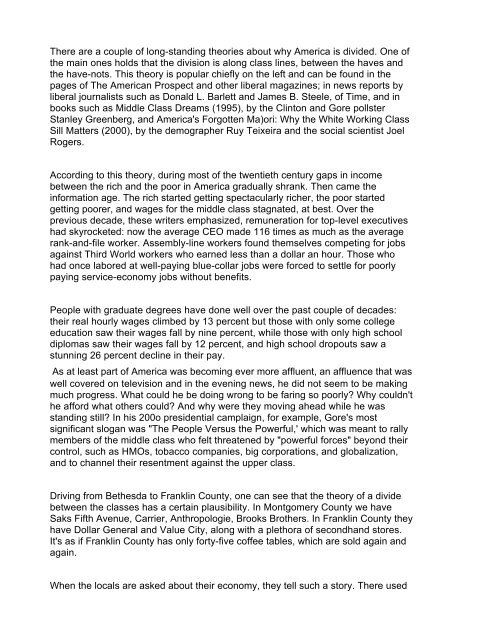One Nation, Slightly Divisible by David Brooks - Saddleback College
One Nation, Slightly Divisible by David Brooks - Saddleback College
One Nation, Slightly Divisible by David Brooks - Saddleback College
Create successful ePaper yourself
Turn your PDF publications into a flip-book with our unique Google optimized e-Paper software.
There are a couple of long-standing theories about why America is divided. <strong>One</strong> of<br />
the main ones holds that the division is along class lines, between the haves and<br />
the have-nots. This theory is popular chiefly on the left and can be found in the<br />
pages of The American Prospect and other liberal magazines; in news reports <strong>by</strong><br />
liberal journalists such as Donald L. Barlett and James B. Steele, of Time, and in<br />
books such as Middle Class Dreams (1995), <strong>by</strong> the Clinton and Gore pollster<br />
Stanley Greenberg, and America's Forgotten Ma)ori: Why the White Working Class<br />
Sill Matters (2000), <strong>by</strong> the demographer Ruy Teixeira and the social scientist Joel<br />
Rogers.<br />
According to this theory, during most of the twentieth century gaps in income<br />
between the rich and the poor in America gradually shrank. Then came the<br />
information age. The rich started getting spectacularly richer, the poor started<br />
getting poorer, and wages for the middle class stagnated, at best. Over the<br />
previous decade, these writers emphasized, remuneration for top-level executives<br />
had skyrocketed: now the average CEO made 116 times as much as the average<br />
rank-and-file worker. Assembly-line workers found themselves competing for jobs<br />
against Third World workers who earned less than a dollar an hour. Those who<br />
had once labored at well-paying blue-collar jobs were forced to settle for poorly<br />
paying service-economy jobs without benefits.<br />
People with graduate degrees have done well over the past couple of decades:<br />
their real hourly wages climbed <strong>by</strong> 13 percent but those with only some college<br />
education saw their wages fall <strong>by</strong> nine percent, while those with only high school<br />
diplomas saw their wages fall <strong>by</strong> 12 percent, and high school dropouts saw a<br />
stunning 26 percent decline in their pay.<br />
As at least part of America was becoming ever more affluent, an affluence that was<br />
well covered on television and in the evening news, he did not seem to be making<br />
much progress. What could he be doing wrong to be faring so poorly? Why couldn't<br />
he afford what others could? And why were they moving ahead while he was<br />
standing still? In his 200o presidential camplaign, for example, Gore's most<br />
significant slogan was "The People Versus the Powerful,' which was meant to rally<br />
members of the middle class who felt threatened <strong>by</strong> "powerful forces" beyond their<br />
control, such as HMOs, tobacco companies, big corporations, and globalization,<br />
and to channel their resentment against the upper class.<br />
Driving from Bethesda to Franklin County, one can see that the theory of a divide<br />
between the classes has a certain plausibility. In Montgomery County we have<br />
Saks Fifth Avenue, Carrier, Anthropologie, <strong>Brooks</strong> Brothers. In Franklin County they<br />
have Dollar General and Value City, along with a plethora of secondhand stores.<br />
It's as if Franklin County has only forty-five coffee tables, which are sold again and<br />
again.<br />
When the locals are asked about their economy, they tell such a story. There used
















